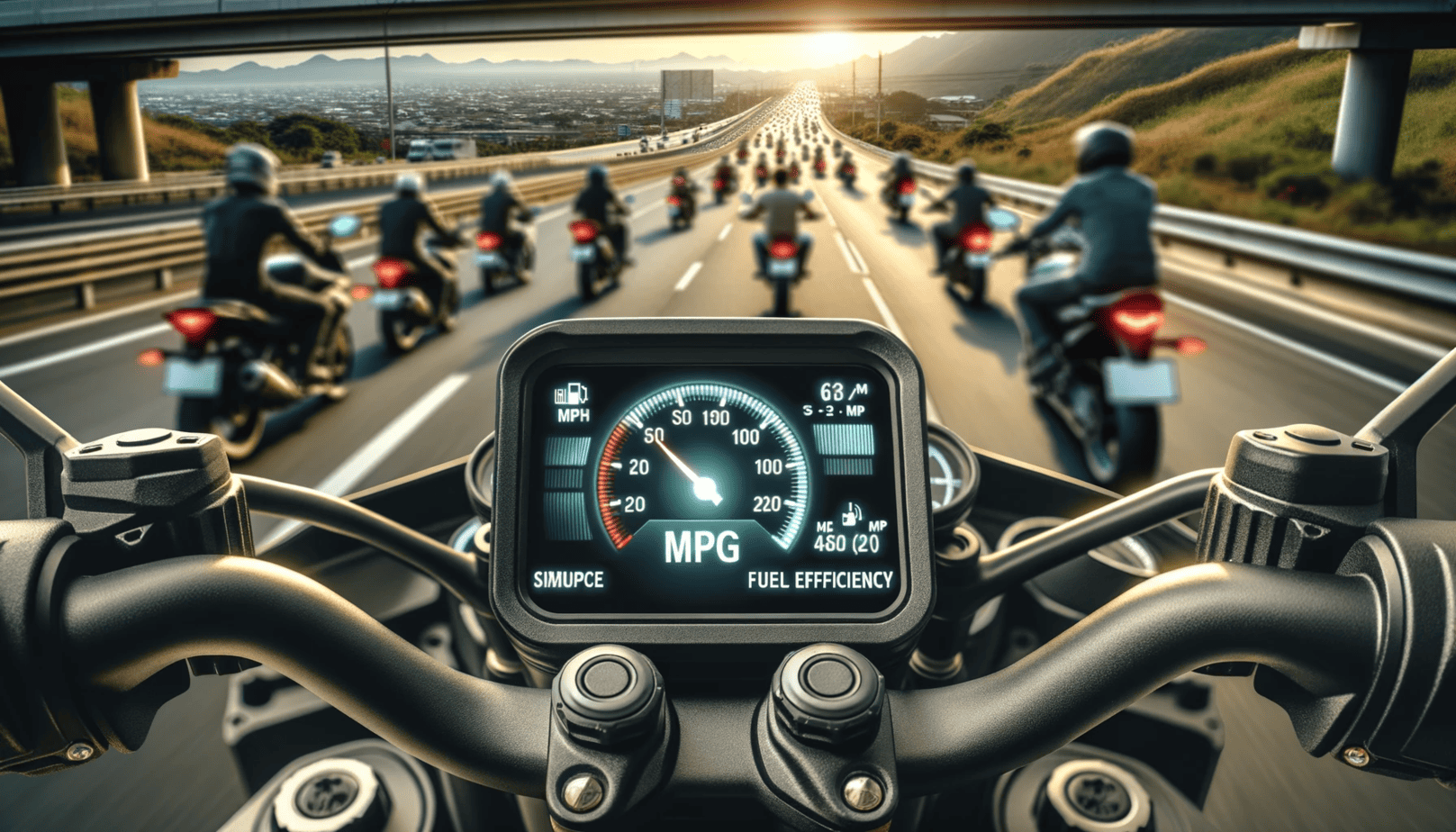Restoring your dream motorcycle and riding down the open road with a bike that you restored bolt by bolting yourself sounds like a dream. Vintage motorcycle restoration requires time, patience, and financial resources, but it’s a highly rewarding project. In this article, I have collected for you some of the most important tips for vintage motorcycle restoration from my personal experience. However, the first and the most important general advice is to love what you’re doing. Restoring a vintage motorcycle doesn’t have to feel like labor, it is supposed to be a pleasure. At the same time, however rewarding it might be, vintage motorcycle restoration requires serious planning and engagement. Using my tips and tricks, it will be easier for you to restore your first motorcycle and feel super proud about it.
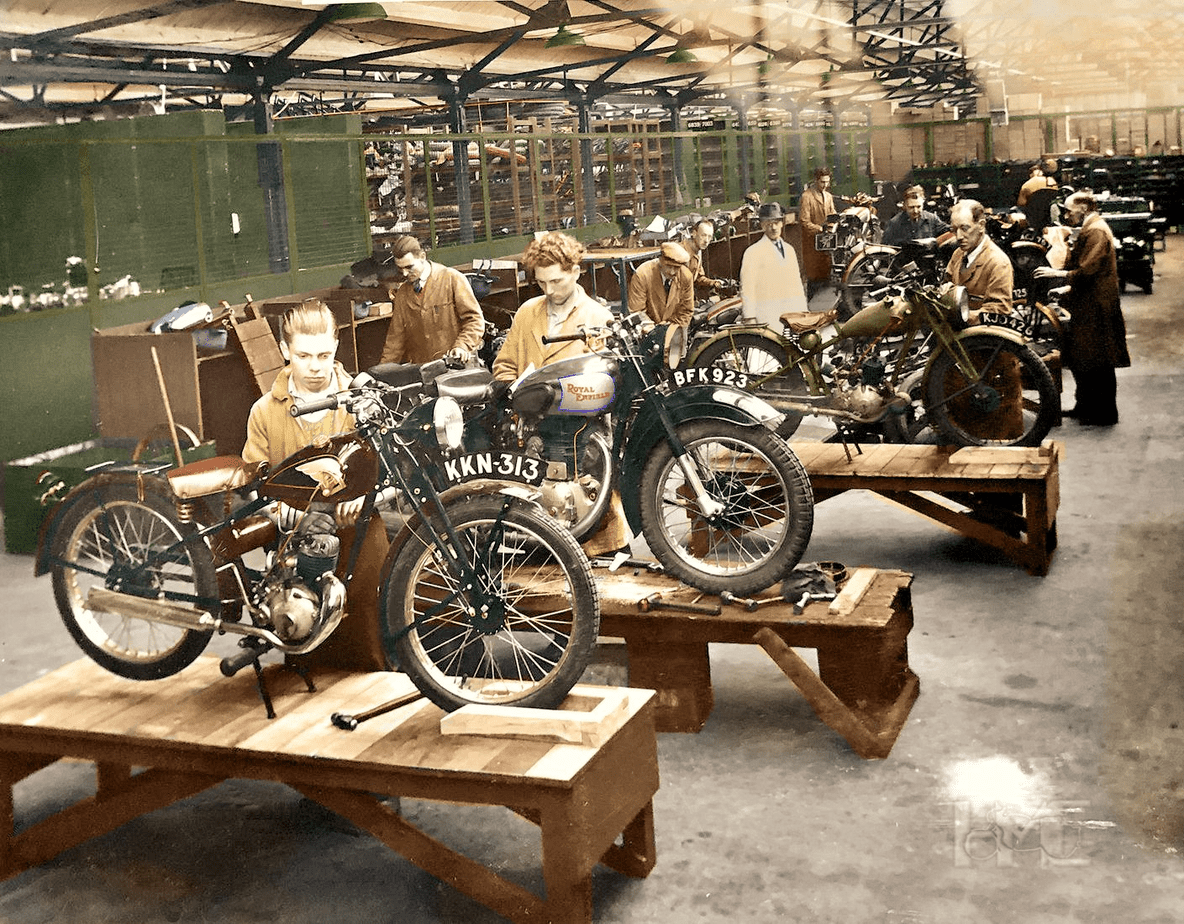
A fascinating photograph of the Royal Enfield service department back in March 1948
General recommendations
It needs a LOT of time
When planning to restore a motorcycle, keep in mind that it is time-consuming labor. So be prepared to spend up to six months even if you’ve planned to be done in a couple. With relevant experience, it is expected that you will need about 350 hours – working on it for a few hours every day and weekends maybe. Without any experience at all, it will take you approx. 400-450 hours (about 5 months). Take your time and use it wisely. Don’t let the process get you overwhelmed. It is important to enjoy it rather than see it as a second job.
Make a realistic timeline for your project and plan accordingly. The time it takes you to rebuild your motorcycle will depend on:
- How well organized you are.
- Availability of replacement parts you’ll need.
- The condition of the bike
- How much of a restoration you’re going to do.
Motorcycle restoration cost
Several factors contribute to determining the overall cost of restoring your motorcycle, which may include:
- The specific make and model of the motorcycle being restored
- The extent to which you intend to restore it to its original condition
- Any additional cosmetic enhancements you plan to incorporate
- The degree to which you plan to customize the frame and overall design.
If your budget is tight, it might be wise to find a bike that’ll only need some minor work – sometimes all an old bike needs is a carb cleaning and a tune-up to get it running again.
When working on a project with a budget in mind, it is important to set realistic goals for your motorcycle restoration. Here are some steps to help you do this:
- Identify which parts are critical and require replacement, as they are essential to the safe and efficient operation of the motorcycle.
- Determine which parts can be repaired instead of replaced. This can save you money and still ensure that the motorcycle is functional.
- Evaluate which parts are nice to have but not crucial to the motorcycle’s performance. These can be postponed if they are not urgent or if you need to manage your budget more effectively.
Most standard rebuilds (get it working and road-worthy again) will typically cost $500 to $1,200 on top of the purchase price.
Focus on safety
When restoring a vintage motorcycle, it’s important to prioritize safety over aesthetics. Make sure that the brakes, suspension, and electrical systems are all in good working order before focusing on cosmetic upgrades. Safety should be your top priority when restoring a vintage motorcycle. Start by inspecting the brakes, suspension, and electrical systems. Replace any worn or damaged parts before moving on to cosmetic upgrades.
Find a mentor
If you’re new to motorcycle restoration, find someone who has the experience and is willing to mentor you. Finding a mentor who has experience with vintage motorcycle restoration can be a valuable resource. They can provide guidance, answer questions, and help you avoid costly mistakes. Look for local motorcycle clubs or sometimes it’s not even necessary to know a mentor like this in person. Look into online forums to find experienced restorers. They can provide valuable guidance and advice.
Research
Do your research before starting the restoration. Find out everything you can about the specific make and model of the motorcycle, including any common problems, issues, or quirks. Use online forums, books, or manuals to research your motorcycle’s specific make and model. Doing research before starting the restoration can help you avoid common problems and make informed decisions about parts and upgrades.
Be flexible
Be prepared to adjust your plans and expectations as you go. Unexpected challenges may arise during the restoration process, and it’s important to be flexible and adaptable.
Choosing a motorcycle
Choose a motorcycle you love
Make sure you love the vehicle that you decide to restore. It takes a lot of effort, money & time and you will get a good result only if you are motivated. I have seen way too many abandoned projects. It should be the kind of vehicle that is special (whether in terms of character or nostalgia).
Where to find a motorcycle
Some places to consider when looking for a motorcycle to repair are:
- Craigslist
- Ebay
- motorcycle salvage yards
- country barns
- storage lockers
- swap meets
Never pay listed price
Typically, when an individual lists an item for sale, the asking price is higher than what they anticipate receiving (unless the phrase “firm on price” is included). This is a well-known fact because sellers expect that buyers will attempt to negotiate the price, which is an integral part of the buying process.
Therefore, it is advisable to negotiate the price of a motorcycle with the owner, regardless of the listed price. It is common to discover that sellers are willing to reduce the price significantly to complete the sale.
Parts
Don’t buy parts all at once
Keep this well in mind: buy your parts only when you need them. Most motorcycle restorations remain incomplete. Parts sitting around get damaged or lost, plans get changed, and new parts have to get brought in instead. To minimize expenses, it is advisable to purchase only the necessary parts at the moment they are required.
Use OEM parts
Whenever possible, use OEM (original equipment manufacturer) parts. Using original equipment manufacturer parts can help ensure that your restored motorcycle looks and performs as close to the original as possible. If you can’t find OEM parts, high-quality aftermarket parts can also be a good option. Use the internet, forums, or specialty shops to find OEM parts. Some parts may be difficult to find, so be patient and persistent in your search.
Be patient when ordering parts
When undertaking a motorbike restoration, sourcing the necessary parts can be a time-consuming task, particularly if your bike is an older model. It is recommended to explore both local and digital resources to locate the parts you need. Online forums, motorcycle dealers, scrap yards, and local mechanics are all valuable sources to consider.
It is important to be aware that searching for original parts can take longer than using alternative parts. By being open to using alternative parts, you can potentially reduce the wait time. But restoring a motorcycle using alternative parts is mostly referred to as “rider restoration” which may not be a full-scale restoration. However, it depends on your needs.
Some of the best online stores for motorcycle parts are:
Have a Plan
To maintain organization throughout your project, it is crucial to create a comprehensive plan that outlines the necessary steps. You should identify the specific areas that require attention and prioritize them in a logical sequence. Once you have established the plan, it is advisable to display it in a prominent location, such as the wall of your garage, to serve as a reference and keep you on track.
The state of your bicycle will largely determine the specific plan of action you need to take, but the following is a general framework that you can use to begin:
- Inspect the battery
- Check the carburetor
- Examine the gas tank for any signs of rust or other issues.
- Inspect the spark plugs to replace them if necessary.
- Check the electrical system
- Test the lights
- Change the oil.
- Inspect the chain and sprockets for wear and replace them if necessary.
- Check the brakes to ensure they are functioning correctly.
- Inspect the tires for wear and replace them if necessary.
- Check the exhaust system for any signs of damage or corrosion.
- Perform any necessary custom work or modifications to improve performance or appearance.
Execution
Get a Bike Service Manual
This manual contains comprehensive information about your motorcycle and is essential for ensuring that repairs and maintenance are performed correctly. If you can obtain an OEM factory repair manual, that is even better. However, note that these manuals are typically not given to buyers, as they are typically reserved for use by service technicians.
The repair manual provides a detailed overview of how the motorcycle was constructed, making it a crucial resource if you intend to rebuild the bike. This information is vital because it enables you to understand precisely how all the parts fit together and function as a cohesive unit, ensuring that your repairs and maintenance are thorough and effective.
Wash Your Bike First
Properly wash your bike even before you start working on it. Thoroughly clean the areas affected by oil leaks or grease buildup using high-pressure washing and degreasing methods, which may involve the use of Kerosene or Diesel by mechanics, which can prevent potential disasters from occurring in the future.
Some parts may need vapor blasting:
Get Organized As You Disassemble
Keep all the parts organized and labeled throughout the restoration process. Keep a spreadsheet or list of all the parts you have and what condition they are in. Keeping all the parts organized and labeled can help you avoid confusion and prevent parts from getting lost or mixed up. It’s also helpful to keep a spreadsheet or list of all the parts you have and what condition they’re in. Use ziplock bags or small plastic containers to store and label parts. Use a sharpie or label maker to clearly label each container with the part’s name and location.
Take pictures – Before you start disassembling the motorcycle, take detailed photos of all angles of the bike. This will help you remember how it all goes back together. Taking pictures before disassembling your motorcycle can help you keep track of the parts and how they fit together. When you’re ready to put the motorcycle back together, you can refer to the pictures to make sure everything is in the right place. Use a digital camera or smartphone and make sure to capture all the details, including any labels or markings.
Take the bike apart in sections and rebuild it as you go. Keep several groups in mind when you dismantle to organize the parts. This way it will be easier to keep working and create less mess. Here are some groups you may consider:
- The gas tank and fuel delivery system
- The carbs
- The suspension and steering
- The electrical system
- The wheels and brakes
- The top end or bottom end of the engine
- The drive system
Check The Carburetor
When rebuilding a motorcycle, one of the most significant challenges you may encounter is starting the bike. Based on my experience, a blocked carburetor is the primary cause of this issue, accounting for around 80% of cases.
When there is an inadequate mixture of air and fuel, it can be challenging to start the motorcycle. Therefore, when you face this issue, the first thing to check is the carburetor. It is better to perform a thorough cleaning and rebuild of the carburetor during a motorcycle restoration to ensure proper functioning.
Check The Fuel Tank
When a motorcycle has been sitting for an extended period, the tank’s interior may develop rust, which could end up clogging the carburetor. It is crucial to address this issue during a motorcycle restoration.
To begin, empty the tank and add nuts and bolts, which can be rattled around to loosen the rust. Next, use a fuel tank cleaner to eliminate any remaining rust or debris from the tank. By doing so, you can ensure that the carburetor and engine are not compromised by rust or debris, allowing your motorcycle to operate smoothly.
Deal With Rust
When performing a motorcycle restoration, it’s important to examine the frame for any signs of rust or corrosion. If you discover any areas that are affected, it’s crucial to address them promptly to prevent further damage.
To begin, remove the tank and carburetors so that you can access the frame easily. Next, use sandpaper or a wire brush to remove any rust or corrosion from the affected areas, bringing the metal down to bare metal. Once you’ve removed all the rust, clean the frame thoroughly and allow it to dry completely.
Metal Rescue is my preferred product for removing rust from metal. The product’s performance is exceptional and the claims made by others about its effectiveness are indeed true. It is a highly reliable rust remover.
| Product | Price | Buy | Image |
| Metal Rescue | $25.95 | Buy on Amazon | |
| Evapo-Rust | $32.16 | Buy on Amazon | |
| Rust-Oleum Gel | $11.88 | Buy on Amazon | |
| WD-40 Specialist Corrosion Inhibitor anti-rust spray | $25.00 | Buy on Amazon | |
| WD-40 Specialist Rust Remover Soak | $141.18 (1 gallon) | Buy on Amazon |
Here’s another easy way to remove rust from cylinder heads:
Afterward, you can apply a primer and then repaint the frame to protect it from future rust or corrosion. By taking these steps, you can help ensure that your motorcycle restoration is successful and that your bike looks great and operates smoothly.
Removing Rusted Bolts From Motorcycle
Depending on the age of the motorcycles, it can be very hard to remove rusted bolts – which is an essential part of vintage motorcycle restoration. You have to make sure that you remove the bolt without breaking it because removing a broken bolt may cost you hours of drilling.
To do that, first, you need to understand the technique.
- Use the easy-out bolt extractor if the wrench does nothing.
- Wrench it in reverse first.
- Push with one hand against the bolt.
- Tap it periodically.
- You can use a breaker bar to get a better torque.
- Keep your hand on the head (of the breaker bar) and put pressure on the bolt.
Once it starts moving, there is the CRUCIAL part of the process that keeps the bolt from breaking. Once the bolt starts moving, the compacted rust starts to break apart. As you spin the bolt out, all this compacted rust is going to seize the bolt. At this point, you have to be careful and instead of pushing harder, you have to move your wrench back and forth to break the rust particles away. This may take some time but it is worth it if it saves you from drilling the broken bolt. After removing the rust, you will be able to remove the bolt itself by hand.
To ease the process, you can use a penetrating liquid – a solvent that helps loosen the bolt. However, when using any kind of penetrating oil, keep in mind that to effectively dissolve rust, penetrating oil requires a certain amount of time. The amount of time required depends on the severity of the rust and its location on the bolt. For instance, it may take between 15 minutes overnight, or possibly longer, to break down rust. In cases where the rust is severe and has penetrated deep into the threads of the bolt, it may take several days of consistently applying the solvent to gradually dissolve the layers of rust, thereby enabling each application to seep further into the threads.
Some of the penetrating fluids you can try are:
| Brand | Price | Buy | Image |
| Aero Kroil | $38. | Buy on Amazon | |
| Liquid Wrench | $12 | Buy on Amazon | |
| B’laster | $18 | Buy on Amazon | |
| Royal Purple | $8.82 | Buy on Amazon | |
| WD-40 | 12$ | Buy on Amazon |
Don’t Skimp On Paint
A good paint job can make all the difference when it comes to the overall look and feel of a restored motorcycle. Don’t skimp on paint and make sure to choose a high-quality product that will last. Use high-quality paint and primer, and follow the manufacturer’s instructions. Proper surface preparation is key to a successful paint job.
Paint Yourself
Painting a motorcycle can be daunting, particularly if you lack experience. The tank’s paint is the most visible aspect of your bike, and it is the first thing that catches people’s attention. Despite this, don’t be afraid to take on the task because painting is not as challenging as it appears.
To paint a motorcycle, you will need to paint the frame and the tank. It is advisable to practice on a scrap piece of metal before attempting to paint the motorcycle to become more familiar with the process. With some practice and confidence in your abilities, you can achieve a beautiful paint job on your motorcycle.
Add Something Personal
Restoring a motorcycle is a great way to personalize it. There are numerous ways to transform an ordinary bike into a showstopper that reflects your individuality, such as installing customized handlebars, adding a striking paint job, or incorporating unique rims. The possibilities for personalizing your bike are virtually limitless, and the result can be an attention-grabbing masterpiece that perfectly embodies your style.
Seek Out Specialized Services
Some parts of the restoration process may require specialized services or expertise, such as machining or welding. Don’t be afraid to seek out these services if needed. Use online directories or local recommendations to find experienced machinists, welders, or other specialists.
Consider Outsourcing
Depending on your skill level and the complexity of the restoration project, you may want to consider outsourcing certain aspects of the work to professionals. This can help ensure that the motorcycle is restored to the highest possible standard. Outsource tasks like engine rebuilding, or upholstery if you don’t have the necessary skills or tools.
Keep Records
Use a notebook or spreadsheet to keep track of all the parts you’ve removed or replaced, and any upgrades or modifications you’ve made. Throughout the restoration process, keep detailed records of all the work you’ve done, including any modifications or upgrades you’ve made. Keeping detailed records of the restoration process can be helpful if you ever decide to sell the motorcycle in the future. It can also help you keep track of the work you’ve done and any modifications or upgrades you’ve made.
Final Thoughts
Enjoy the Process
Restoring a vintage motorcycle is a labor of love. Enjoy the process and take pride in bringing an old bike back to life.
Take Breaks
Restoring a vintage motorcycle can be a time-consuming and sometimes frustrating process. Taking breaks can help you avoid burnout and maintain your motivation and enthusiasm for the project. It’s important to take care of yourself and avoid pushing yourself too hard.
Ask For Help When You Need It
If you encounter a specific and detailed issue while working on your motorcycle, it can be helpful to consult online forums for guidance. Particularly, if you are working on a common or popular motorcycle, it is likely that someone else has experienced a similar problem and may have found a solution.
By seeking advice and insights from others who have gone through similar situations, you can benefit from their knowledge and expertise. This can help you avoid potential mistakes or missteps, as well as save time and money in the long run.
Finally, if you would love to have some sort of a manual, check the The Beginner’s Guide to Classic Motorcycle Restoration. This is a great book that provides a detailed guide to classic motorcycle restoration, including how to source a bike and expert techniques, tips, and tricks. It will save time and money and demonstrates that expert knowledge or a fully-fitted workshop is not necessary to restore a dream bike. With photographs and detailed instructions, the book is an ideal companion for any classic motorcycle restorer. It helped me through my first journey of motorcycle restoration.
Even a good cleaning may do the job sometimes. Check this out:
But here are some of the amazing results of vintage motorcycle restorations:
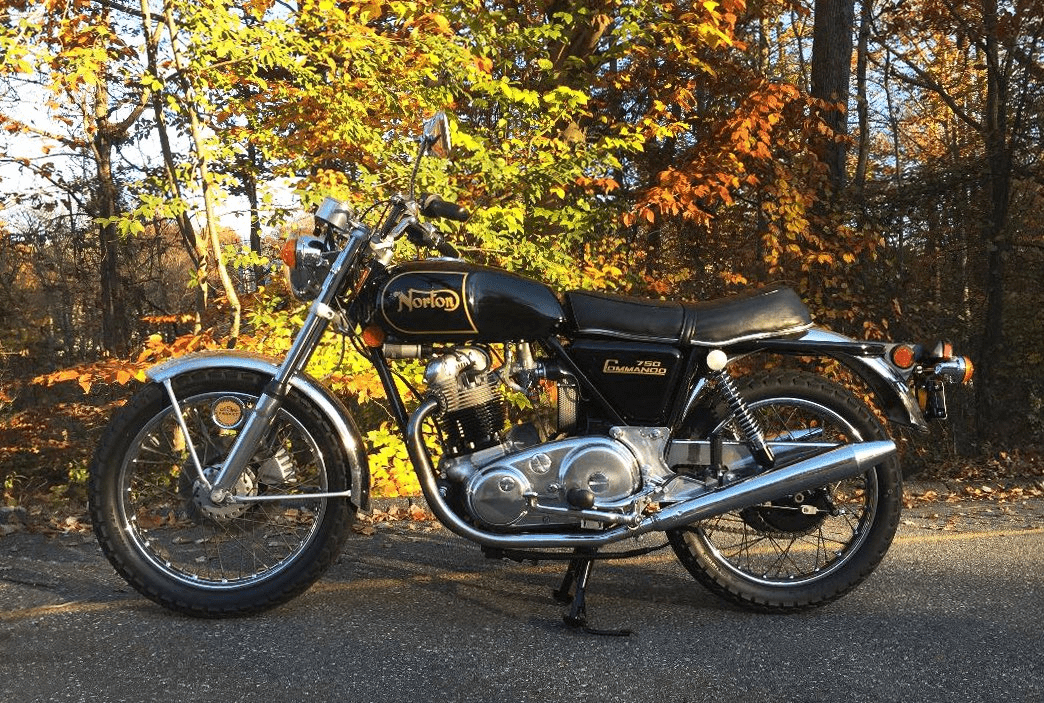
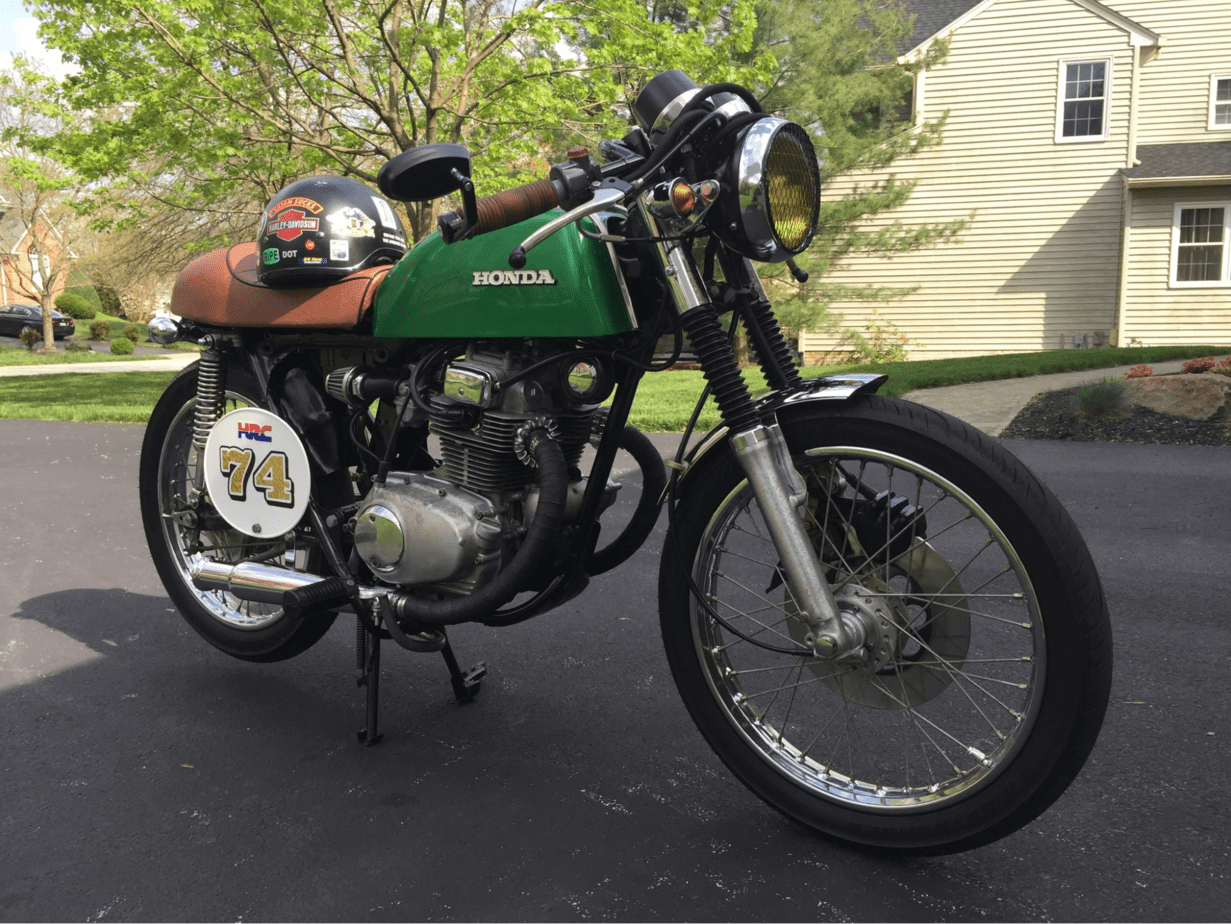
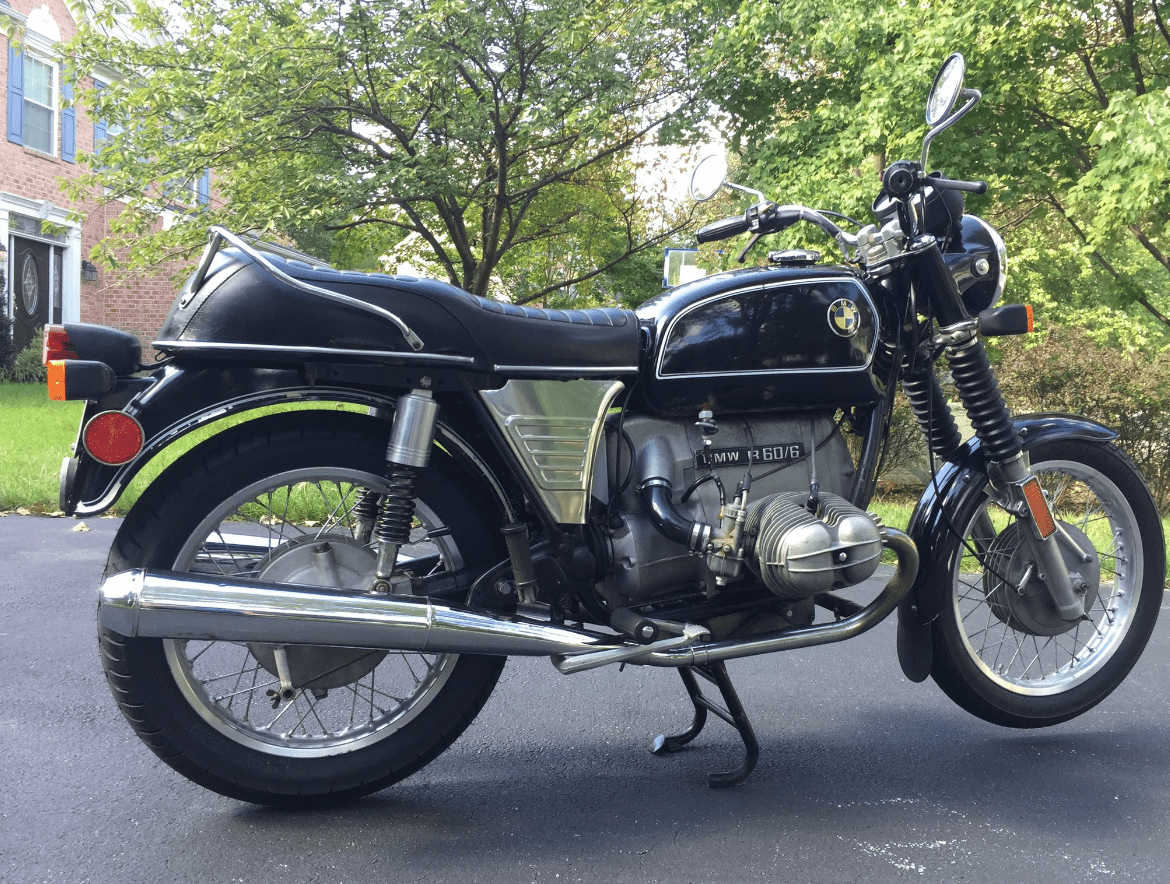
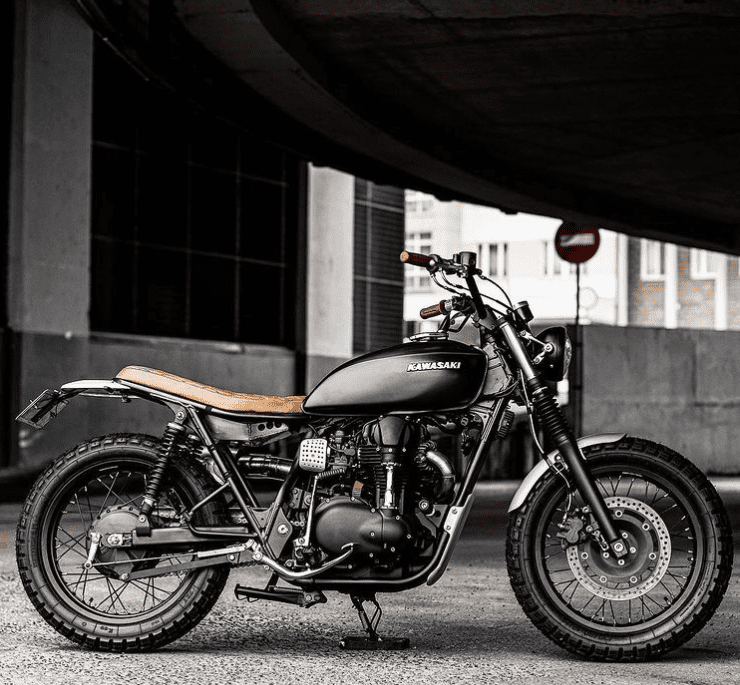
Bruce was born in Atlanta. He started riding motorcycles when he was 10 and has been passionate about them since. Bruce says he feels absolute freedom when he’s on two wheels. He prefers riding his bike slowly and smoothly along a country road and hardly ever enjoys wildly speedy rides. With a strong Ducati Multistrada 1200 in the current stable, Bruce enjoys his super powerful, comfortable and easy rides. Ducati Diavel is the beast he’s currently dreaming about…
